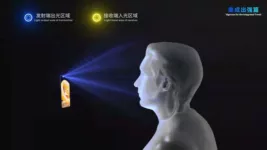The era of full-display smartphones is coming. And the bezel-less display effect depends on under-display camera (UDC) technology. The quality of the under-display camera solution will be one of the decisive factors for OLED panel manufacturers to win in the future.
On May 5, Visionox held its Technology Innovation Launch Event online to release its innovative technologies in five sectors, covering nearly 20 technological achievements. Its upgraded under-display camera solution InV see® has aroused the industry’s attention.
Visionox’s Under-display 3D Face Recognition Technology Meets Payment-level Certification Standards
The system integration of under-display camera and 3D face recognition technologies has been realized by Visionox’s bezel-less under-display 3D face recognition solution, which is the first in the whole world.
The basic principle of under-display camera technology is that the front camera is covered with a transparent OLED screen which displays contents under normal circumstances. When the front camera is turned on, the OLED screen becomes transparent, enabling the shooting function.
The basic principle of under-display 3D face recognition technology is that two transparent display areas with high pixel density and high infrared light transmission rate are set at the upper part of the phone. When the 3D face recognition is enabled, the two areas can capture basic data on core facial features with the help of under-display camera technology. Then by comparing them with the facial data saved in the system, the results of the Match Recognition can be obtained.
The screen must take into account both the display clarity and the transmission rate in photo shooting, which was once the biggest problem of the under-display camera. With the efforts of Visionox, the stability and maturity of under-display camera technology have laid the foundation for the system integration of 3D face recognition.
The biggest difficulty of under-display 3D face recognition is the setting of multiple transparent display areas. Based on its own patented TFT side mount technology, Visionox redesigned the driving backplane to realize the co-existence of multiple transparent display areas each with higher pixel density than 400ppi, which can truly achieve the integration of transparent display areas and main display area, making the transparent display area invisible to human eyes. At the same time, multiple transparent display areas can be arranged in space with flexibility to meet the technical requirements of various 3D face recognition modules such as structured light and time-of-flight.
The under-display 3D face recognition technology developed by Visionox has met the payment-level certification standard.
Continuously Iterate UDC Technologies and Expand Laptop Applications
These achievements are the result of 16 years of hard work of the R&D staff. Visionox’s under-display camera research team has put years of effort into the realization of one goal. As early as 2006, they had applied for a patent on transparent screen; in 2020, they brought forward the world’s first mass-producible under-display camera solution; in 2021, the technology was iterated and upgraded; and in 2022, it will be iterated again.
As a company engaged in under-display camera innovation and development earlier than its peers, Visionox has built a comprehensive patent system with technologies and inventions covering the most extensive layout of core fundamental patents. For example, the invention of the Four Firsts (“the first small anode solution”, “the first drive circuit edge placement”, “the first one-drive multi-pixel/multi-drive multi-pixel array design”, and “the first serpentine electrode routing solution”), covering multiple patent groups for arrays, devices, drives, and materials, which has enabled Visionox to build its core and key technological barriers. Having the most and earliest authorizations and more than one thousand patents, Visionox has a dominating position when it comes to patents.
This has ensured Visionox’s leading position in the field of under-display camera. With two iterations, Visionox’s first-mover advantage has further expanded, while the technical advantages will also drive its market expansion.
It is learned that Visionox’s under-display camera solutions can satisfy the under-display camera requirements of hard display, flexible display, high-end flexible display, medium-sized display, etc., fully capable of customizing and developing for customer needs. With its “One strength & Two new roads” strategy, the application of under-display 3D face recognition will also be extended to the field of laptops or automotive displays.
According to Visionox, it will further enhance transparency, control diffraction, and optimize cameras and algorithms to achieve a better selfie effect. It will integrate more under-display sensing technologies such as under-display 3D face recognition, under-display ambient light sensing, etc. Moreover, it plans to further reduce the mass production cost of under-display cameras and increase the production capacity to benefit more consumers.







